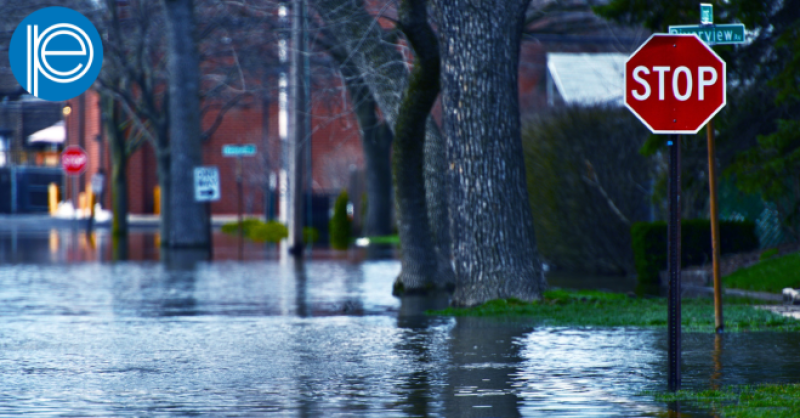Evaluating Your Entity's Properties for Potential Flood Events
- 7/11/2024 10:00 am

Almost every property is vulnerable to flooding from lakes, rivers or significant rain events. Regardless of where the water comes from, damage to your facilities can impact your ability to serve the public.
A typical property policy does not include flood coverage, but under the Public Entity Partners’ property and crime policy, flood coverage is offered under automatic coverages at a base level of $1 million. For members with a total insured value (TIV) of less than $1 million, the automatic coverage for flood is equal to the TIV.
If your organization owns facilities in a high-risk flood category, you should also evaluate whether you need to purchase coverage from the National Flood Insurance Program (NFIP). For facilities that are eligible for NFIP flood coverage, PE Partners flood coverage is excess over NFIP available limits.
In October 2021, FEMA introduced Risk Rating 2.0 as an update to the NFIP’s risk rating method. According to FEMA, there are currently 27,500 NFIP residential and commercial policies in force in Tennessee. However, there are still more than 2.5 million properties in Tennessee without NFIP coverage. If your entity has facilities in the high-risk flood category, we encourage you to consider purchasing flood coverage through NFIP.
As you evaluate your facilities, the property valuation provided by PE Partners can assist you. Each scheduled location valued at more than $100,000 is reviewed at least once every four years, and the complete property valuation report provided to each member includes relevant flood map information. You can also review flood maps directly on FEMA’s website.
In addition, PE Partners recommends the following best practices for flooding:
- If possible, avoid flood-prone areas when evaluating locations for new properties.
- Analyze your existing facilities in flood zones for their ability to withstand expected events.
- Use temporary levees or landscaping for barriers.
- Stock disaster supplies, including portable power equipment, to maintain utility services.
- Place main electrical service equipment on the upper floors of structures or elevated platforms above historical flood-stage heights.
- There should be no open flames or non-waterproof electrical wiring in a flood-prone structure.
- Install shut-offs or disconnects for gas and water piping above the expected flood stage.
- Discontinue electrical service to the structure if possible.
- After a flooding event, assess the damage to building foundations, inspect all electrical equipment before restarting them and clear any clogged drains. Do not attempt to unclog drainage pipes or grates until after the water has receded.
- Remove all vehicles and equipment from flood-prone structures prior to flooding.
This article is for informational purposes and, as always, please review all policy conditions, exclusions and endorsements.
For questions about your property policy or any of the included automatic coverages, please reach out to our Underwriting Department.
East Tennessee
Janine Helton
615.371.6013
Middle Tennessee
Aliyah Turner
615.373.4791
West Tennessee
Stacey Zimmerle
615.610.9213
Categories
-
Annual Report
(5)
-
Audit Requests
(2)
-
Board of Directors
(18)
-
Claims
(26)
-
Cyber Extension
(4)
-
Cyber Security
(27)
-
Dividend
(7)
-
EHS Hero & HR Hero
(16)
-
Employment Practices Liability
(26)
-
Excellence In Risk Management Awards
(18)
-
Fireworks
(1)
-
First Responders
(9)
-
Grants
(23)
-
Law Enforcement
(16)
-
Local Government Risk Academy
(4)
-
Loss Control
(105)
-
Member Services
(11)
-
Message From the President
(19)
-
MTAS
(10)
-
Municipal Sewer System
(4)
-
Partnering for Success Webinar Series
(30)
-
PEP Staff
(32)
-
Qualified Immunity
(3)
-
Risk & Insurance Symposium
(42)
-
Safety Program
(56)
-
Scholarships
(19)
-
Social Media
(2)
-
Training
(76)
-
Underwriting
(32)
-
Workers' Compensation
(27)
- Annual Report (5)
- Audit Requests (2)
- Board of Directors (18)
- Claims (26)
- Cyber Extension (4)
- Cyber Security (27)
- Dividend (7)
- EHS Hero & HR Hero (16)
- Employment Practices Liability (26)
- Excellence In Risk Management Awards (18)
- Fireworks (1)
- First Responders (9)
- Grants (23)
- Law Enforcement (16)
- Local Government Risk Academy (4)
- Loss Control (105)
- Member Services (11)
- Message From the President (19)
- MTAS (10)
- Municipal Sewer System (4)
- Partnering for Success Webinar Series (30)
- PEP Staff (32)
- Qualified Immunity (3)
- Risk & Insurance Symposium (42)
- Safety Program (56)
- Scholarships (19)
- Social Media (2)
- Training (76)
- Underwriting (32)
- Workers' Compensation (27)